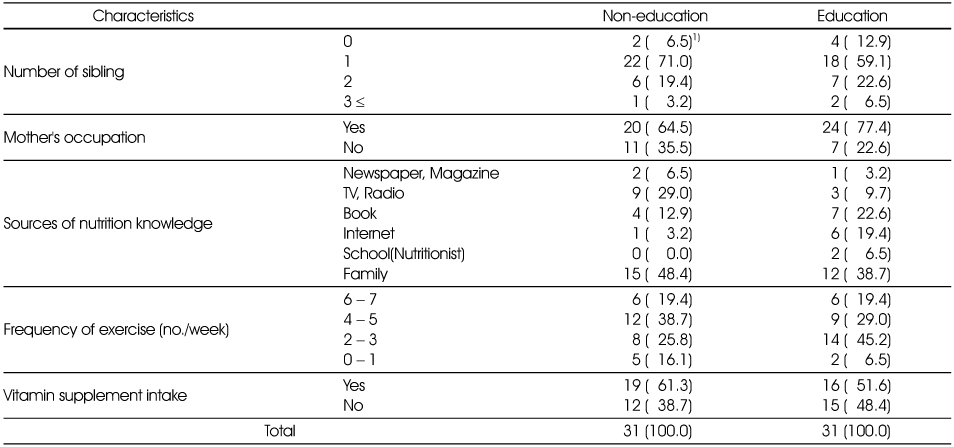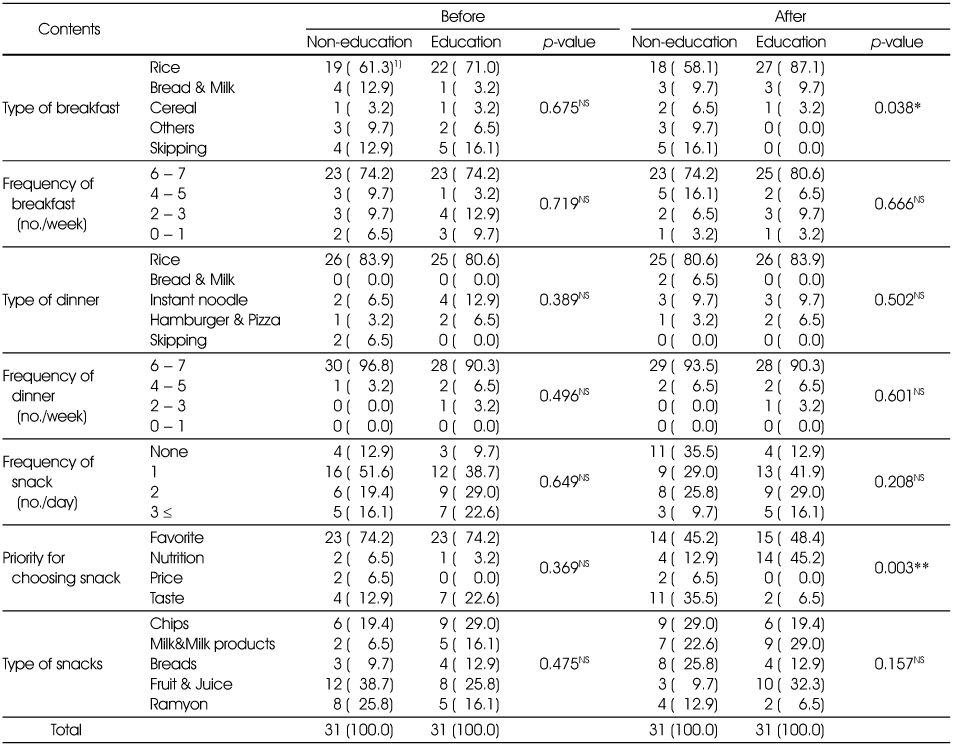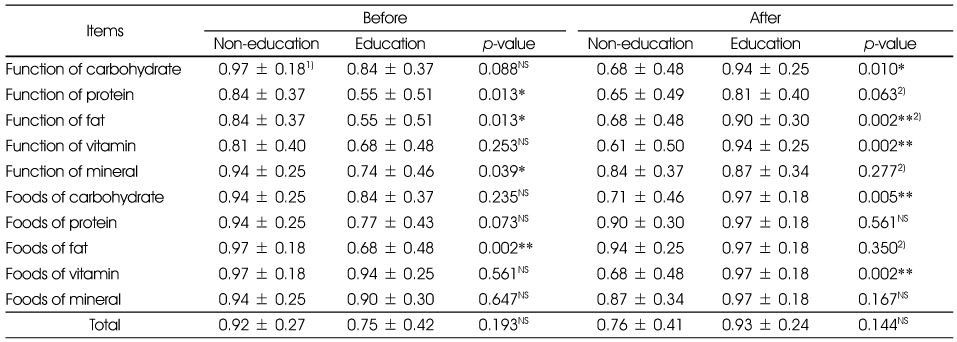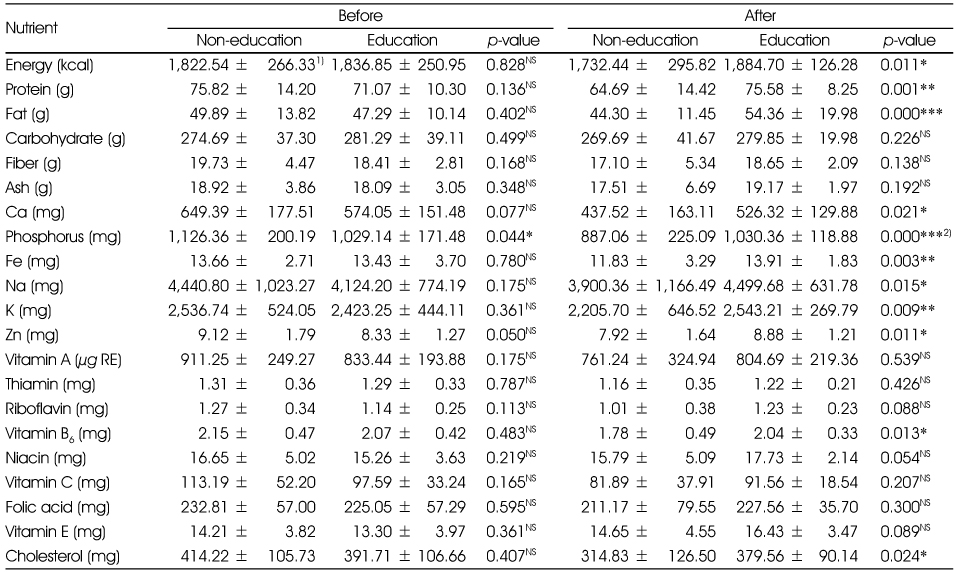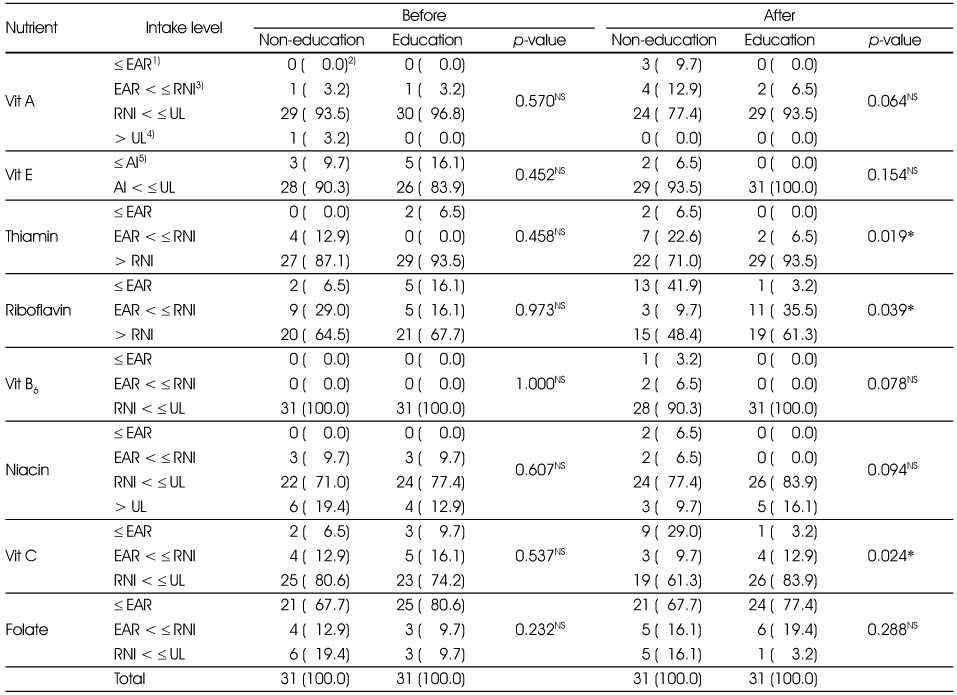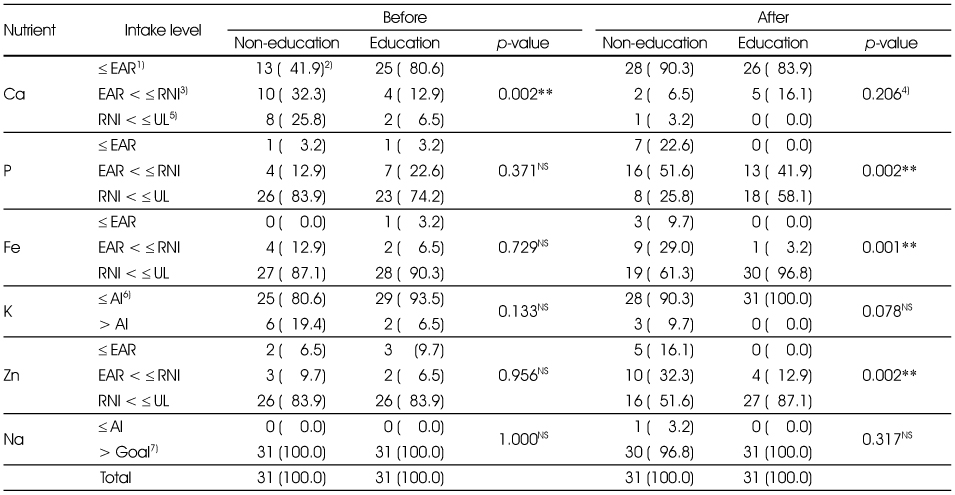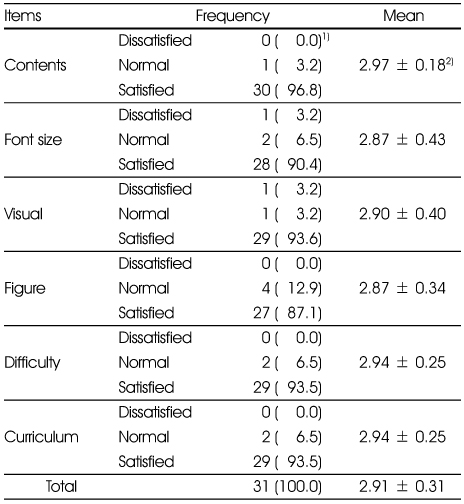References
1. Ahn Y, Ko SY, Kim KW. Evaluation of a nutrition education program for elementary school children. Korean J Community Nutr 2009. 14(3)266–276.
2. Busan National University of Education, Department of Practical Arts Education. Playing food tower with Toto 2010. cited 2010 July 15. Available from
http://www.foodtower.net/.
3. Changwon National University, Department of Food and Nutrition. Jjang & food friend 2010. cited 2010 July 15. Available from
http://www.food79.net/.
4. Cho YO, Kim BY. Evaluation of vitamin B6 status and RDA in young Koreans. Ann Nutr Metab 2004. 48235–240.
5. Cho Y, Kim Y. Dietary intake and major dietary sources of vitamin B-6 in Korean young women. Nutr Sci 2001. 420–25.
6. Choi SJ, Sohn HS, Cha YS, Kim SB. A study on middle school students' recognition of food and nutrition part in home economics. Korean J Community Nutr 2004. 9(1)12–18.
7. Choi MK, Lee YS, Lee YS, Bae YJ, Kim MH, Lee YS, Kim AJ, Sung CJ. Evaluation of nutritional health camp in obese elementary students. Korean J Food Nutr 2007. 2079–87.
8. Chungbuk National University, Applied Nutrition Laboratory. I food 2010. cited 2010 July 15. Available from
http://ifood.or.kr/.
9. Cohen HW, Hailpern SM, Fang J, Alderman MH. Sodium intake and mortality in the NHANES follow-up study. Am J Med 2006. 119275.e7–275.e14.
10. Cole K, Waldrop J, D'Auria J, Gamer H. An integrative research review: effective school-based childhood overweight interventions. J Spec Pediatr Nurs 2006. 11(3)166–177.
11. Eom HS, Jeong MJ, Kim SB. A study on nutrition knowledge, dietary attitude, food habit of middle school students in Chonbuk area. Korean J Community Nutr 2005. 10(5)574–581.
12. Han HM, Lee SS. A nutrition education program development and the application for the elementary students - Focused on sugar intake education -. J Korean Pract Arts Educ 2008. 21(2)111–131.
13. Hong SY. Basic statistics 2004. Seoul: Hakjisa;
14. Hyon SM, Kim JW. Improvement of dietary attitudes of elementary students by nutrition labeling education. Korean J Community Nutr 2007. 12(2)168–177.
15. Kang SA, Lee JW, Kim KE, Koo JO, Park DY. A study of the frequency of food purchase for snacking and its related ecological factors on elementary school children. Korean J Community Nutr 2004. 9(4)453–463.
16. Kim GM, Lee SY. The study on nutritional knowledge and eating behavior of elementary school senior students in Incheon area. J Korean Diet Assoc 2000. 6(2)97–107.
17. Kim JY, Han YS, Bae HY, Ahn HS. Dietary intakes and serum lipid and iron indices in obese children. Korean J Community Nutr 2006. 11(5)575–586.
18. Kim KA, Lee YK. The effect of nutrition education using animations on the nutrition knowledge, eating habits and food preferences of elementary school students. Korean J Community Nutr 2010. 15(1)50–60.
19. Kim OH, Park HA, Cho YG, Kim KW, Hur YI, Song JH, Kang JH. Health status and nutrient intakes of 5th grade elementary students in Seoul and Gyeonggi province. Korean J Community Nutr 2010. 15(6)717–726.
20. Kim SB, Choi HJ. Effects of nutrition education using food exchange system: changes in elementary students' nutrition knowledge, dietary attitude and nutrients intake. Korean J Community Nutr 2008. 13(6)922–933.
21. Kim SH, Hyun TS. Evaluation of a nutrition education website for children. Korean J Community Nutr 2006. 11(2)218–228.
22. Koo JO, Lee JW, Choi YS, Kim JH, Lee JH. Nutrition throughout the life cycle 2006. Seoul: Hyo-Il Publishing Co.;
23. Korea Center for Disease Control and Prevention. Korean children and adolescent national growth chart 2007. cited 2010 August 1. Available from
http://www.cdc.go.kr/.
24. Korea Health Industry Development Institute. Korea National Health and Nutrition Examination Survey (KNHANES -3) 2009.
25. Ku PJ, Lee KA. A survey on dietary habit and nutritional knowledge for elementary school children's nutritional education. Korean J Diet Cult 2000. 15(3)201–213.
26. Kyeon YK, Jang YA, Kim JW. Application of a practical nutrition education program, KHIDI KIDS, for the improvement of dietary attitudes and habits of elementary students. Korean J Nutr 2006. 39(8)808–816.
27. Lee JY, Lee SY. A comparative study on nutrition knowledge, eating behavior and nutrient intake for students at elementary schools with and without nutrition education program. J East Asian Soc Diet Life 2004. 14(6)561–570.
28. Lee KA. Activity-based nutrition education for elementary school students. Korean J Food Nutr 2003. 36(4)405–417.
29. Lee YJ, Kim GM, Chang KJ. The analysis of effect on nutrition education of elementary school children, Inchon. J Korean Diet Assoc 2000. 6(2)86–96.
30. Lee YM, Lee MJ, Kim SY. Effects of nutrition education through discretional activities in elementary school -Focused on improving nutrition knowledge and dietary habits in 4th-, 5th- and 6th- grade students-. J Korean Diet Assoc 2005. 11(3)331–340.
31. Ministry for Health, Welfare and Family Affairs, Korea Centers for Disease Control and Prevention. Korea National Health and Nutrition Examination Survey (KNHANES-3) 2009.
32. Moon HK, Park Y, Park JH. Evaluation of a nutrition education program for 5th grade students provided by community health centers in the Seoul metropolitan area. J Korean Diet Assoc 2008. 14(3)259–275.
33. Park YS, Lee JW, Seo JS, Lee BK, Lee HS. Nutrition education and counseling 2007. Seoul: Kyo-moon Publishing Co.;
34. Rural Development Administration & The Korean Community Nutrition Society. Children's nutrition guide 2009. Paju: Kyomunsa;
35. Shim JE, Paik HY, Moon HK. Breakfast consumption pattern, diet quality and health outcomes in adults from 2001 National Health and Nutrition Survey. Korean J Nutr 2007. 40(5)451–462.
36. Son MJ, Cho YS, Kim SN, Seo HJ, Kim SB. Development of effects' analysis of nutrition education pamphlet for the lower grades elementary students-Focused on individual daily needed food exchange units-. Korean J Community Nutr 2011. 16(6)647–660.
37. Son SM, Lee KH, Kim KY, Lee YK. Practices in nutrition education and counseling 2009. Seoul: Life Science Publishing Co.;
38. The Korean Dietetic Association. Dietitian(teacher)'s Guide 2007.
39. The Korean Nutrition Society. Dietary reference intakes for Korean 2010. Seoul: Han-Arum Publishing Co.;
40. Trumbo P, Schlicker S, Yates AA, Poos M. Dietary reference intakes for energy, carbohydrate, fiber, fat, fatty acids, cholesterol, protein and amino acids. J Am Diet Assoc 2002. 102(11)1621–1630.
41. Wardlaw GM, Hampel JS, Dislivestro RA. Perspectives in nutrition 2004. 6th edth ed. New York: McGraw Hill;
42. Whiting SJ, Vatanparast H, Baxter Jones A, Faulkner RA, Mirwald R, Bailey DA. Factors that affect bone mineral accrual in the adolescent growth spurt. J Nutr 2004. 134696S–700S.
43. Yi MJ. Effects of nutrition education on dietary change of middle school girls in Jeonju -with educated group and non-educated group as the center- 2007. Chonbuk National University; 3–12.
MS thesis.


